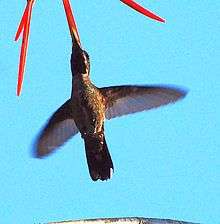Plain-capped starthroat
| Plain-capped starthroat | |
|---|---|
 | |
| Scientific classification | |
| Kingdom: | Animalia |
| Phylum: | Chordata |
| Class: | Aves |
| Order: | Apodiformes |
| Family: | Trochilidae |
| Genus: | Heliomaster |
| Species: | H. constantii |
| Binomial name | |
| Heliomaster constantii (Delattre, 1843) | |
The plain-capped starthroat (Heliomaster constantii) is a large-sized hummingbird. It is 11–12 cm long (4.33–4.72 inches), and weighs approximately 7-8 g.
Adults are colored predominantly metallic bronze on their upper-parts, tail, back and crown. The bird has a dark eye-stripe with a white stripe above and below. The starthroat also has a white patch on the rump. The throat patch, or gorget, is a metallic violet-red. The breast and underparts are a grayish white. The bill is straight, long and very slender. It is darkly colored. The female is slightly less colorful than the male.
The breeding habitat occurs in various habitats of western Mexico, (the Sierra Madre Occidentals), to southern Costa Rica. It has occasionally been recorded in south-easternmost Arizona of the United States, the Madrean sky islands of the Sierra Madre ranges. In the U.S. the bird is usually seen between mid-June and mid-Sept, in the Chiracahua and Huachuca Mountains of Arizona. It is not present in the U.S. every year. Most recently it has been seen at Tucson's Agua Caliente Park in June 2007, at California Gulch (Arizona) in June 2008 and at Patagonia (Arizona) in September 2010.
These birds feed on nectar from flowers and flowering trees using a long extensible tongue or catch insects on the wing.
References
- ↑ BirdLife International (2012). "Heliomaster constantii". IUCN Red List of Threatened Species. Version 2013.2. International Union for Conservation of Nature. Retrieved 26 November 2013.
External links
- Stamps bird-stamps.org (for Mexico-with a RangeMap)
- Plain-capped Starthroat photo-High Res (VIREO-Photo); Article w/RangeMap InfoNatura NatureServe
- Photo; Article SABO-Hummingbirds of Arizona
- Plain-capped Starthroat photo gallery VIREO Photo-High Res--(Close-up)
- Plain-capped Starthroat videos on the Internet Bird Collection
